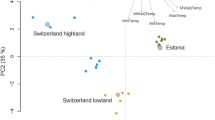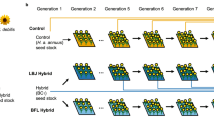Abstract
We created Recombinant Inbred Lines (RILs) derived from a cross between ecotypes of Avena barbata associated with moist (mesic) and dry (xeric) habitats in California. Traits which were correlated with fitness across RILs mapped to the same Quantitative Trait Loci (QTLs) as fitness. However, different QTL affected fitness in different environments so that fitness was weakly correlated across environments. Recombination released considerable heritable variation both in fitness, and in ecologically relevant traits. Many traits showed transgressive segregation caused by recombination of QTL associated in repulsion phase in the parents. In addition, some traits were uncorrelated, allowing novel combinations of those traits to be created. Recombination also created heritable variation in reaction norms for at least one trait (root allocation). Altogether these results suggest that recombination can combine the most selectively advantageous genes and traits of the parents to produce broadly adapted genotypes that are capable of outperforming the parents. Indeed, two of the RILs showed higher fitness than the parental ecotypes across a range of environmental treatments in the greenhouse, but their superiority was less pronounced in the field. Although late-generation recombinants exhibited hybrid breakdown, being less fit, on average, than the mid-parent, early generation hybrids appear to exhibit hybrid vigour through the expression of dominance effects in the heterozyotes. This vigour may offset the effects of hybrid breakdown in the early generations following a cross, enhancing the opportunity for recombination to create broadly adapted genotypes. We discuss the implications of these findings to the evolution of colonizing species.




Similar content being viewed by others
Abbreviations
- QTL:
-
Quantitative trait locus
- RIL:
-
Recombinant inbred line
- RMR:
-
Root mass ratio
- GxE:
-
Genotype by environment interaction
- HREC:
-
Hopland Research and Extension Center
- SFREC:
-
Sierra Foothills Research and Extension Center
- AFLP:
-
Amplified fragment length polymorphism
References
Ainouche ML, Baumel A, Salmon A, Yannic G (2004) Hybridization, polyploidy and speciation in Spartina (Poaceae). New Phytol 161:165–172
Allard RW (1965) Genetic systems associated with colonizing ability in predominantly self-pollinated species. In: Baker HG, Stebbins GL (eds) The genetics of colonizing species. Academic Press, New York, pp 50–78
Allard RW (1999) History of plant population genetics. Annu Rev Genet 33:1–27
Allard RW, Babbel GR, Clegg MT, Kahler AL (1972) Evidence for coadaptation in Avena barbata. Proc Natl Acad Sci USA 69:3043–3048
Allendorf FW, Lundquist LL (2003) Introduction: population biology, evolution and control of invasive species. Conserv Biol 17:24–30
Anderson E, Stebbins GL (1954) Hybridization as an evolutionary stimulus. Evolution 8:378–388
Arnold ML (1997) Natural hybridization and evolution. Oxford University Press, New York
Baker HG (1965) Characteristics and modes of origin of weeds. In: Baker HG, Stebbins GL (eds), The genetics of colonizing species. Academic Press, New York, pp. 147–172
Barton NH (2001) The role of hybridization in evolution. Mol Ecol 10:551–568
Burke JM, Arnold ML (2001) Genetics and the fitness of hybrids. Annu Rev Genet 35:31–52
Clausen J (1949) Genetics of climatic races of Potentilla glandulosa. Hereditas (Suppl.) pp 162–172
Clausen J (1953) New bluegrasses by combining and rearranging genomes of contrasting Poa species. Proc 6th Int Grassland Congr, Univ. Park, Pa., 1952, pp 216–221
Clausen JC, Keck D, Heisey WM (1948) Experimental studies on the nature of plant species. III. Environmental responses of climatic races of Achillea. Carnegie Institution of Washington, Washington DC, USA, Publication 581
Clegg MT, Allard RW (1972) Patterns of genetic differentiation in the slender wild oat species Avena barbata. Proc Natl Acad Sci USA 69:1820–1824
Dyer AR, Rice KJ (1999) Effects of competition on resource availability and growth of a California bunchgrass. Ecology 80:2697–2710
Ellstrand NC, Schierenbeck KA (2000) Hybridization as a stimulus for the evolution of invasiveness in plants? Proc Natl Acad Sci USA 97:7043–7050
Fenster CB, Galloway LF (2000) Population differentiation in an annual legume: genetic architecture. Evolution 54:1157–1172
Fry JD (1996) The evolution of host specialization: are trade-offs overrated? Am Nat 148:S84–S107
Fry JD, Nuzhdin SV, Pasyukova EG, McKay TFC (1998) QTL mapping of genotype–environment interaction for fitness in Drosophila melanogaster. Genet Res 71:133–141
Futuyma DJ (2001) Ecological specialization and generalization. In: Fox CW, Roff DA, Fairbairn DJ (eds) Evolutionary ecology: concepts and case studeis. Oxford University Press, London UK, pp 177–189
Futuyma DJ, Moreno G (1988) The evolution of ecological specialization. Annu Rev Ecol Syst 19:207–223
Garcia P, Vences FJ, Perez de la Vega M, Allard RW (1989) Allelic and genotypic composition of ancestral spanish and colonial Californian gene pools of Avena barbata: evolutionary implications. Genetics 122:687–694
Gardner KM (2004) The genetic architecture of fitness related traits in Avena barbata. PhD Dissertation, Dalhousie University
Gardner KM, Latta RG (2006) Identifying loci under selection across contrasting environments in Avena barbata using quantitative trait locus mapping. Mol Ecol 15:1321–1333
Grant V (1981) Plant speciation, 2nd edn. Columbia University Press, New York, USA
Hamrick JL, Holden L (1979) Influence of microhabitat heterogeneity on gene frequency distribution and gametic phase disequilibrium in Avena barbata. Evolution 33:521–533
Hawthorne DJ, Via S (2001) Genetic linkage of ecological specialization and reproductive isolation in pea aphids. Nature 412:904–907
Hedrick PW, Holden L (1979) Hitch-hiking: an alternative to coadaptation for the barley and slender wild oat examples. Heredity 43:79–86
Holmes TH, Rice KJ (1996) Patterns of growth and soil–water utilization in some exotic annuals and native perennial bunchgrasses of California. Ann Bot 78:233–243
Hufford KM, Mazer SJ (2003) Plant ecotypes: genetic differentiation in the age of ecological restoration. Trends Ecol Evol 18:147–155
Hutchings MJ, de Kroon H (1994) Foraging in plants: the role of morphological plasticity in resource acquisition. Adv Ecol Res 25:159–238
Hutchinson ES (1982) Genetic markers and ecotypic differentiation of Avena barbata Pott. ex Link. PhD Dissertation, University of California, Davis
Hutchinson ES, Hakim-Elahi A, Miller RD, Allard RW (1983) The genetics of diploidized tetraploid Avena barbata. J Hered 74:325–330
Jain SK, Rai KN (1980) Population biology of Avena. VIII. Colonization experiment as a test of the role of natural selection in population divergence. Am J Bot 67:1342–1346
Jin H, Domier LL, Shen XJ, Kolb FL (2003) Combined AFLP and RFLP mapping in two hexaploid oat recombinant inbred populations. Genome 43:94–101
Johansen AD (2004) Fitness consequences of hybridization between ecotypes of Avena barbata. PhD Dissertation, Dalhousie University
Johansen-Morris AD, Latta RG (2006) Fitness consequences of hybridization between ecotypes of Avena barbata: hybrid breakdown, hybrid vigour and transgressive segregation. Evolution (in press)
Kassen R, Bell G (2000) The ecology and genetics of fitness in Chlamydomonas. X. The relationship between genetic correlation and genetic distance. Evolution 54:425–432
Kawecki TJ, Barton NH, Fry JD (1997) Mutation collapse of fitness in marginal habitats and the evolution of ecological specialization. J Evol Biol 10:407–429
Kremer CA, Lee M, Holland JB (2001) A restriction fragment length polymorphism based linkage map of a diploid Avena recombinant inbred line population. Genome 44:192–204
Latta RG, MacKenzie JL, Vats A, Schoen DJ (2004) Divergence and segregation of quantitative traits between allozyme genotypes of Avena barbata from contrasting habitats. J Ecol 92:57–71
Lee CE (2002) Evolutionary genetics of invasive species. Trends Ecol Evol 17:386–391
Lee CE, Remfert JL, Gelembiuk GW (2003) Evolution of physiological tolerance and performance during freshwater invasions. Integ Comp Biol 43:439–449
Lexer C, Randell RA, Rieseberg LH (2003) Experimental hybridization as a tool for studying selection in the wild. Ecology 84:1688–1699
Lynch M, Gabriel W (1983) Phenotypic evolution and parthenogenesis. Am Nat 122:745–764
Lynch M, Walsh B (1998) Genetics and analysis of quantitative traits. Sinauer Associates, Inc., Sunderland
MacKay TFC (2001) The genetic architecture of quantitative traits. Annu Rev Genet 35:303–339
MacKenzie A (1996) A trade-off for host plant utilization in the black bean aphid Aphis fabae. Evolution 50:155–162
Mather K, Jinks JL (1982) Biometrical genetics: the study of continuous variation. Chapman and Hall, London
Nagy ES (1997) Selection for native characters in hybrids between two locally adapted plant subspecies. Evolution 51:1469–1480
Rieseberg LH (1997) Hybrid origins of plant species. Annu Rev Ecol Syst 28:359–389
Rieseberg LH, Archer MA, Wayne RK (1999) Transgressive segregation, adaptation and speciation. Heredity 83:363–372
Rieseberg LH, Widmer A, Arntz AM, Burke JM (2003) The genetic architecture necessary for transgressive segregation is common in both natural and domesticated populations. Phil Trans R Soc Lond B 358:1141–1147
Roff DA (1997) Evolutionary quantitative genetics. Chapman and Hall, New York
Sakai AK, Allendorf FW, Holt JS, Lodge DM, Molofsky J, With KA, Baughman S, Cabin RJ, Cohen JE, Ellstrand NC, McCauley DE, O’Neil P, Parker IM, Thompson JN, Weller SG (2001) The population biology of invasive species. Annu Rev Ecol Syst 32:305–332
van Tienderen PH (1992) Variation in a population of Plantago-lanceolata along a topographical gradient. Oikos 64:560–572
Verhoeven KJF, Vanhala TK, Biere A, Nevo E, Van Damme JMM (2004) The genetic baiss of adaptive population differentiation: a quantitative trait locus analysis of fitness traits in two wild barley populations from contrasting habitats. Evolution 58:270–283
Via S, Lande R (1985) Genotype–environment interaction and the evolution of phenotypic plasticity. Evolution 39:505–522
Vos P, Hogers R, Bleeker M, Reijans M, Vandalee T, Hornes M, Fijters A, Pot J, Peleman J, Kuiper M, Zabeau M (1995) AFLP—a new technique for DNA fingerprinting. Nucl Acids Res 23:4407–4414
Weinig C, Dorn LA, Kane NC, German ZM, Halldorsdottir SS, Ungerer MC, Toyonaga Y, Mackay TFC, Purugganan MD, Schmitt J (2003) Heterogeneous selection at specific loci in natural environments in Arabidopsis thaliana. Genetics 165:321–329
Williamson M (1996) Biological invasions. Chapman and Hall, New York
Zeng ZB (1994) Precision mapping of quantitative trait loci. Genetics 136:1457–1468
Acknowledgements
This work would have been impossible without the help and support of many people. Dr. Pedro Garcia very kindly provided the seeds from which the RILs were derived. Greenhouse support was provided by Carman Mills and a large group of undergraduate students. Field support was generously provided by Robert Keiffer, Chuck Vaughn, Mike Connor and Dave Labadie and the staff of Hopland Research and Extension Centre and Sierra Foothills Research and Extension Center of the Division of Agriculture and Natural Resources, University of California. DNA analyses were conducted in the Dalhousie Marine Gene Probe Laboratory with invaluable input from Doug Cook. The work has benefited greatly from the support and input of Dan Schoen, Jim Hamrick, Kevin Rice, John McKay, Mark Johnston, Christophe Herbinger, Joanna MacKenzie, and Angel Vats. This work was financially supported by the Natural Sciences and Engineering Research Council of Canada through a Research Grant to RGL and through Post Graduate Scholarships to ADJ and KMG. This paper was submitted for the symposium entitled, “All Stressed Out and Nowhere to Go: Does Evolvability Limit Adaptation in Invasive Species?” at the 2004 SSE/SSB/ASN conference in Fort Collins, CO, organized by Carol Lee and George Gilchrist.
Author information
Authors and Affiliations
Corresponding author
Rights and permissions
About this article
Cite this article
Latta, R.G., Gardner, K.M. & Johansen-Morris, A.D. Hybridization, recombination, and the genetic basis of fitness variation across environments in Avena barbata . Genetica 129, 167–177 (2007). https://doi.org/10.1007/s10709-006-9012-x
Received:
Accepted:
Published:
Issue Date:
DOI: https://doi.org/10.1007/s10709-006-9012-x




